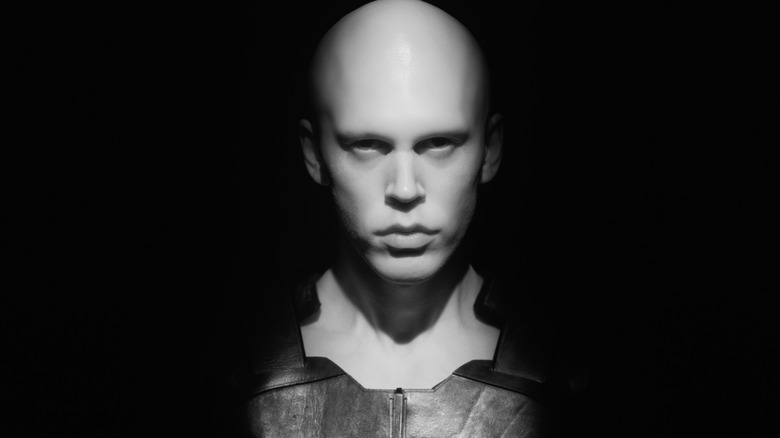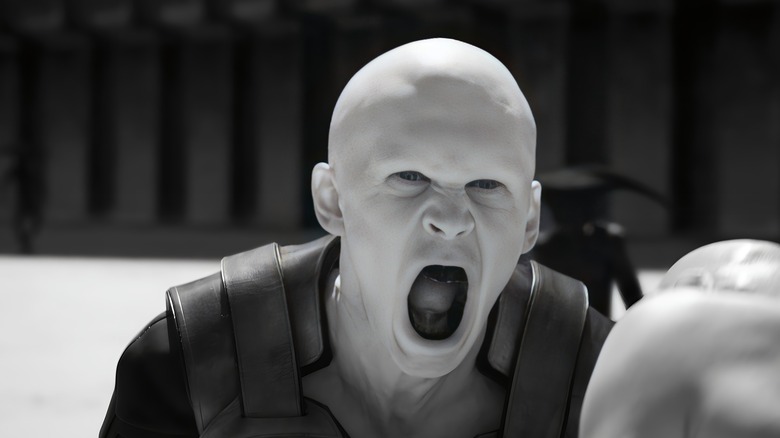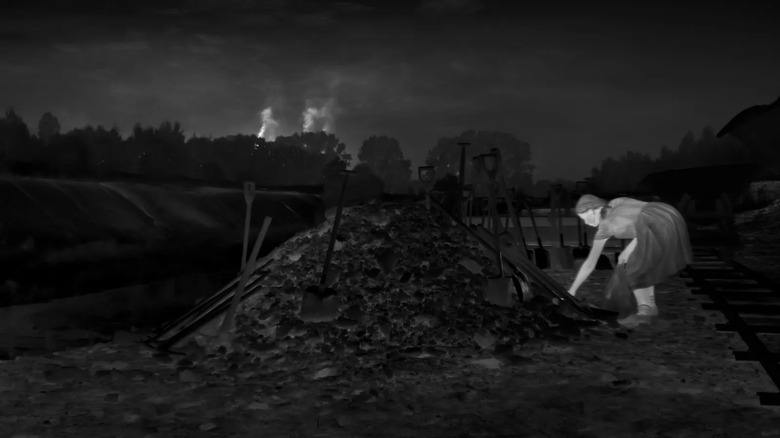How Dune 2 Shot Those Mind-Blowing Arena Scenes On Giedi Prime
"Dune: Part Two" seriously blew everyone away at the box office, and if you saw it, you likely recall the film's sudden shift to black and white when the narrative travels to Giedi Prime. Home to the Harkonnens, the planet's sun doesn't create any color, which led to a stunning effect within "Dune: Part Two" for a scene where one bad guy, Baron Vladimir Harkonnen (Stellan Skarsgård), allows his nephew Feyd-Rautha (Austin Butler) to slaughter captives for sport in an enormous gladiator's arena. (It is his birthday, after all.)
So how did director Denis Villeneuve and cinematographer Greig Fraser (known for projects like "The Mandalorian" and "The Batman") create Giedi Prime? Fraser spoke to Vulture about the Harkonnen planet sequence and explained that it isn't in traditional black and white, and nope, they didn't drain color out of a finished product in post-production. They used an ALEXA camera, which allowed them to utilize an infrared setting. According to the outlet, the camera "[could then capture] light beyond the spectrum that is visible to the human eye."
"It's the same camera that we shot the film on," Fraser revealed, "but we modified it." As the piece points out, the end result sort of looks like the footage one might get off of a Ring doorbell camera, because those are able to get solid images using only infrared light when it's dark outside.
Denis Villeneuve had a very specific vision for Giedi Prime
Obviously, the stark, monochromatic look of Giedi Prime is a sharp contrast to the rest of "Dune: Part Two," which takes place largely on the desert planet of Arrakis. Characterized by sweeping sands and beautiful, pink-hued sunsets, Arrakis is where Paul Atreides (Timothée Chalamet) trains to be a Fremen warrior alongside his fellow fighter Chani (Zendaya), who becomes his romantic partner. Watching training sequences of Paul and Feyd-Rautha in completely different environments is a stunning way to set the stage for their eventual showdown. As Greig Fraser revealed, a lot of consideration went into this crucial contrast.
"We need to know that we're not in a gladiator environment in Arrakis. So the sun had to be different." Enter the infrared effect, which Fraser says he and Denis Villeneuve both really loved: "It's that sort of ghoulish look that you get from that light at night from security cameras, but it's happening in the middle of the day." Fraser also told the outlet that only the extended areas of the Giedi Prime arena are computer-generated; the field, most of the walls, and the Baron's box were all real sets.
"Dune: Part Two" isn't the only major release in recent memory to use infrared, actually. And in one Oscar-nominated A24 film, infrared is used to indicate a feeling of total surveillance.
Two major films in theaters now use infrared shots to shock viewers
Though it was released in late 2023, Jonathan Glazer's stunning 2024 Oscar nominee "The Zone of Interest" features infrared sequences just like "Dune: Part Two" — and while both are used as indicators of soullessness and evil, the infrared scenes in "The Zone of Interest" are even more troubling than those set on the Harkonnen planet of Giedi Prime. The movie focuses on an idyllic family home located next to the Auschwitz-Birkenau concentration camp, and pretty much all of the movie is shot in color, except for scenes where an unnamed girl hides food around the camp's workplaces (ostensibly for those imprisoned to find and eat).
Glazer and his own cinematographer Łukasz Żal wanted this scene to look distinct — like the Giedi Prime scenes in "Dune: Part Two" — but they also wanted to use their thermal cameras, which were actually military grade, to capture the girl's light in the darkness as well as realistically shoot a nighttime scene. As Glazer told Vanity Fair, "Here's a girl [...] in a construction site that was full of slave labor during the day. How are you going to see her if you can't use lights? ... What's the only tool that exists where we'll be able to see something that our eyes couldn't? That was a thermal camera." The girl's image was captured by heat rather than light, creating a chilling effect.
Both "Dune: Part Two" and "The Zone of Interest" — films made by auteurs at the top of their respective games — utilize this effect for maximum impact. It's stunning to see it at work, albeit in two very distinct ways. Both movies are in theaters now.


